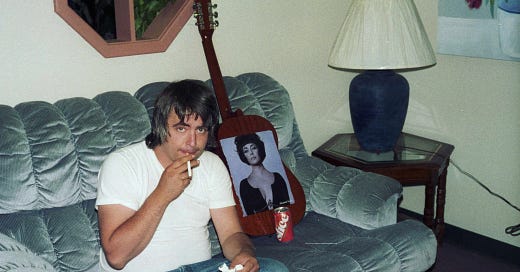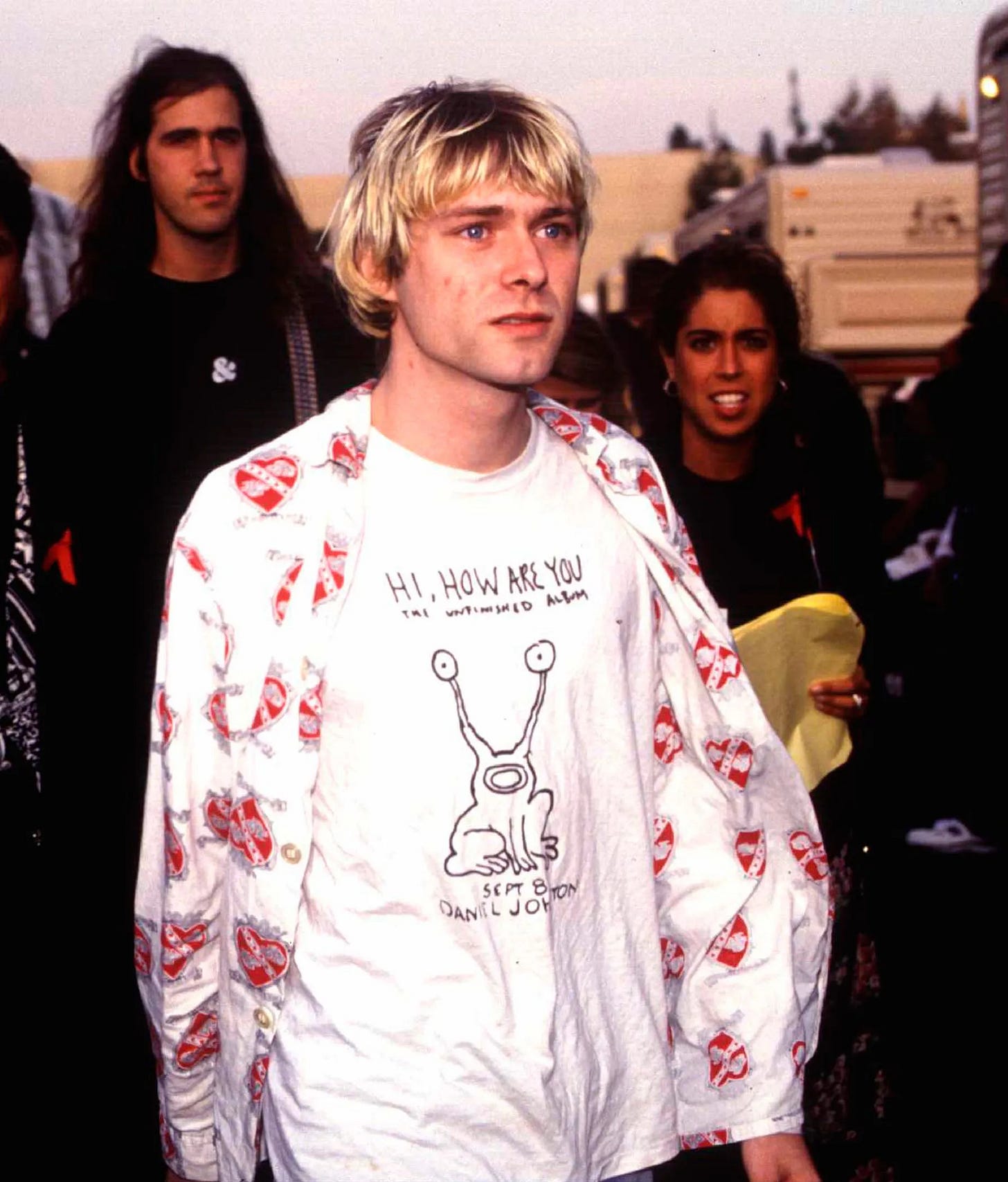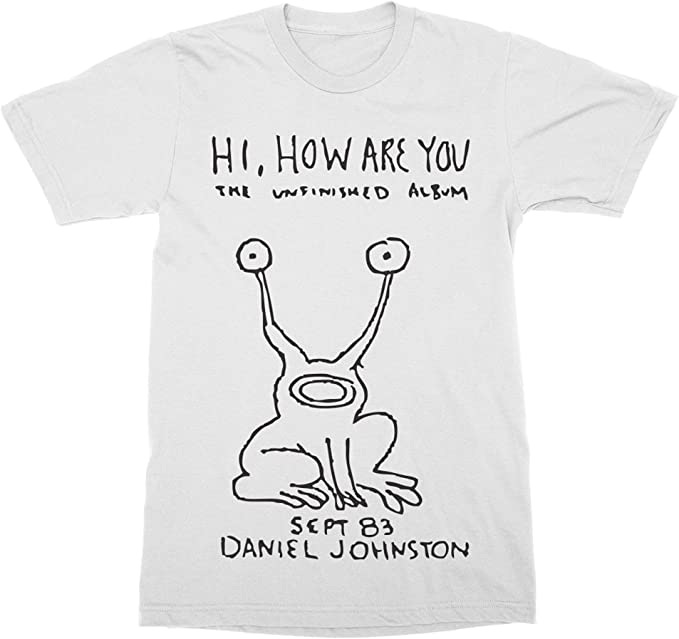Daniel Johnston, the songwriter and artist, paced anxiously outside the Austin Convention Center, tightly gripping an extra-large cup of soda. Inside, several hundred people had gathered to watch “The Devil and Daniel Johnston,” a documentary about his life and career being screened as part of the South by Southwest music festival. Mr. Johnston had dutifully shown up for question-and-answer sessions after each of the three screenings at the festival but couldn’t bring himself to watch the film itself.
When asked why, he answered in a rush of words, avoiding eye contact: “I enjoy it very much, but I’m waiting for it to come out on DVD and then I’ll give it a good listen.”
Of course, the reasons for Mr. Johnston’s unease with the film were more complicated than a preference for DVD’s. At 44 and with gray in his raggedy moptop, he is unlike most of the next big things that the SXSW festival celebrates. He does not look like “buzz band” material.
Still, 2005 might be the year that his work will finally be exposed to a wider public, thanks to the film and the recent release of an anthology of his songs.
Mr. Johnston is already well known to the musical cognoscenti, his reputation established by nine homemade audio cassettes that were first distributed in the mid-1980’s, when he lived here. Crudely recorded on a boombox, they were filled with tape hiss and had titles like “Songs of Pain,” “Yip/Jump Music” and “Hi, How Are You.” They also featured classic pop melodies (some cribbed from the Beatles), his fabulously expressive piano playing and his idiosyncratic voice, a high-pitched lisp. The covers featured his drawings of an eccentric cast of characters: a boxer with a sawed-off head, a creature that bore a striking resemblance to Casper the Friendly Ghost. Mr. Johnston sold them on street corners and at a local McDonald’s restaurant. (Now they can be purchased for $5 from the small Texas label, Stress Records, at www.museumoflove.com.)
Mr. Johnston has had opportunities before to break through to a larger audience. In 1985 an MTV show called “The Cutting Edge” did an episode on the Austin scene, and he was a featured performer. In the 1990’s, Kurt Cobain of Nirvana famously took to wearing a T-shirt decorated with one of Mr. Johnston’s fanciful drawings. In 1994, after signing a deal with Atlantic Records, Mr. Johnston even released a major label album called “Fun.”
But one thing that has held Mr. Johnston back is his sometimes debilitating struggle with manic depression, an illness that has helped fuel his creativity while leading to behavior that has both threatened his life and contributed to his legend. For example, Mr. Johnston first landed in Austin after running away from his family and spending five months selling corn dogs with a traveling carnival. Then there was the incident in 1990 when he tried to leave his father’s prop plane in midair, leading to a crash in the middle of Arkansas.
The Johnston family has since reconciled, and in recent years Mr. Johnston has maintained a course of medication that has brought him greater stability. He now lives in nearby Waller, Tex., with his parents, Mabel, 81, and William, 82, who acts as his manager. And now, he is attracting new attention. In late 2004 a small New York label, Gammon Records, released “The Late Great Daniel Johnston,” a career-spanning two-CD anthology and tribute by veteran musicians like Tom Waits and the Flaming Lips and buzzed-about younger artists like Death Cab for Cutie, Bright Eyes and TV on the Radio. Earlier this month, Beck’s rendition of “True Love Will Find You in the End” was used in an episode of “The OC” on Fox. And in January, when “The Devil and Daniel Johnston” had its debut at Sundance, its creator, Jeff Feuerzeig, won the director’s award in the festival’s documentary competition. (Sony Pictures Classics plans to distribute the film to theaters.)
At the screening here in mid-March, Mr. Johnston was watched over by his older brother, Dick, 51, who has taken a break from his job as a computer consultant to serve as Daniel’s chaperone.
“Dan hasn’t watched the film since the first time,” he said, referring to the premiere at Sundance, which the entire family watched. “He saw part of it Tuesday, but he writhes at certain scenes. It’s very uncomfortable for him.”
Much of the narration is in his own taped voice, drawn from the audio diary that he has maintained since he was a teenager.
When Mr. Feuerzeig was invited to explore the Johnston family’s home, he discovered hundreds of these tapes, which included dozens of undiscovered songs.
“There’s a whole multimedia plan, starting with the DVD and the bonus materials,” Mr. Feuerzeig’s producer, Henry Rosenthal, said. “There’s a coffee table artbook in the works.”
“Done by a museum,” Mr. Feuerzeig added.
“Gallery exhibitions worldwide,” Mr. Rosenthal said.
“Then a box of cassettes, just the early work, which is his most fertile period,” Mr. Feuerzeig said.
“And of course concert tours,” Mr. Rosenthal added.
The mention of tours was the first indication that Mr. Johston might be an active participant in the career that their documentary celebrates. Although Mr. Johnston now performs in a handful of shows each year, some fans who picked up “The Late Great Daniel Johnston” at first thought the CD set was issued to mark his death. In fact, the compilation was a benefit to help raise money to build Mr. Johnston his own home and pay for his medical care.
Currently, his main source of income is his drawings. In the late 1990’s, he began exhibiting his drawings, which are heavily influenced by Jack Kirby, a Marvel Comics illustrator Mr. Johnston cites as the 20th century’s greatest artist.
Despite such eccentricities, Mr. Johnston seems remarkably self-aware. He knows that some perceive his music and career to be tragic or even exploitative. For example, the CD cover shows Mr. Johnston standing over a gravestone etched with his name, above an epitaph that reproduces the title of one song, “Sorry Entertainer.” His fans cite such self-parody as evidence that he’s neither naive nor an outsider artist.
A similar spirit comes through Mr. Johnston’s assessment of the film that may bring his art to the masses. “At first I thought it was a comedy, but when I saw it, it was more like ‘Hard Copy,’ “ he said. “Daniel goes to jail. Daniel goes to the hospital. Daniel crashes a plane. Over all, I think it’s pretty good, but they should have added a laugh track.”
Originally published in The New York Times on April 3, 2005.





